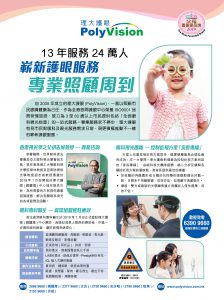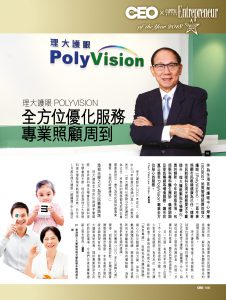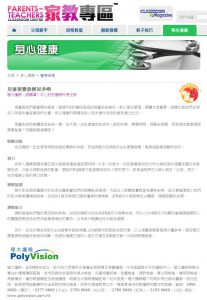有機會是青光眼徵狀的可能性,建議作全面眼科視光檢查,查明真正原因。
請問可否檢查色弱狀況 及有沒有什麼輔助工具可以幫助 進行身體檢查的色覺測試項目 例如色弱眼鏡 等等 謝謝! 可用email與我聯絡
本中心的全面眼科視光檢查已包括利用石原氏 (Ishihara) 圖表或附助工具進行色覺普查,評估應診者是否患有遺傳性色弱。另外,本中心亦有提供其他較精確的顏色粒排列測試,能準確判斷應診者的色弱程度,詳情可直接致電各中心查詢。色弱問題暫時未有方法可處理,而本中心亦暫時沒有提供予色弱患者的協助工具。
斜視怎麼辦
斜視可分為幾類,有隱性、顯性、內斜、外斜等,並會有不同的的幅度及發病頻率,因此處理的時間及深度,要視乎閣下的情況而定。建議閣下先找眼科視光師作全面眼科視光檢查,了解清楚眼睛內外健康狀況,再由眼科視光師作進一步的建議。
小朋友8歲,眼睛各75度近視,現在適合配帶控制近視的鏡片,如Myosmart 嗎?會否太早?
經眼科視光師作詳細眼睛檢查及評估, 8歲小朋友亦可考慮配戴控制近視的鏡片。
近5歲大兒童有三百多度散光和少量遠視,請問除了佩帶眼鏡,還有没有其他醫治方法可做?
建議可先配帶眼鏡協助,並定期作詳細眼睛檢查監察小朋友視力發展情況,待日後小朋友慢慢成長,開始有足夠自理能力後,再由眼科視光師判斷適合轉用其他處理方法(如隱形眼鏡等)與否。
小女7歳,請問一般的賣眼鏡店舖驗眼和貴公司有什麼分別?因我不知道應帶她到那兒驗眼?因她經常眨眼,不知有沒有關係。
本中心主要是提供全面眼睛及視覺護理的護眼中心,轄下的眼科視光師均屬第I部分註冊,能夠使用診斷藥物作全面眼科視光檢查。而5間中心亦設有配鏡部,應付應診者於檢查後有配鏡需要的需求,當然亦接受持有效度數紙人士到來各中心配眼鏡。
孩子頻繁眨眼的原因有很多,可能是因為他們感到眼睛乾澀,因此會常眨眼來分泌更多的淚水。亦有可能是眼睛感到有異物感,例如有塵埃碎屑等異物或睫毛入眼所引起的,這有機會會刮傷角膜表面。另外,亦會因近視或遠視令他們視力模糊,以為頻繁眨眼能夠看清一點。而閣下孩子7歳正值視力發展黃金期,建議定期帶孩子作全面眼科視光檢查,查明真正原因,防止因眼睛看不清而導致視力發展遲緩的風險。
《Super Parents》Brand Awards 2019
(Chinese Version Only)
13年服務24萬人
嶄新護眼服務 專業照顧周到
自2005年成立的理大護眼(PolyVision),一直以照顧市民眼睛健康為己任,作為全港首間護眼中心榮獲ISO9001品質管理認證,致力為3至80歲以上市民提供包括「全面眼科視光檢查」的一站式服務。專業服務永不停步,理大護眼有見市民對眼科及視光服務需求日增,現更積極推動不一樣的嶄新護眼服務﹕
香港視光學之父胡志城教授 – 義務咨詢
享譽國際、世界眼科視光學會及亞太眼科視光學會前主席、現任香港理工大學眼科視光學院榮休教授胡志城教授應邀於2019年1月份開始於理大護眼(銅鑼灣)中心抽空接見市民,為有需要的市民提供專業諮詢服務,解決有關眼科視光的各項疑問及困難。
眼科專科醫生 – 資深加盟 進駐應診
首位資深眼科專科醫生於2019年1月份正式進駐理大護眼(銅鑼灣)中心應診,為疑似或患上眼疾的應診者,作進一步專科眼科檢查,嚴防病情急速惡化﹕
- 綜合眼科﹕玻璃體視網膜病、角膜病、乾眼症、青光眼、眼眶及眼皮、影像診斷
- 小兒眼科﹕近視控制 (阿托品)、斜視、弱視
- 白內障手術﹕飛秒激光、微創超聲波乳化手術
- 矯視手術﹕LASIK 激光、SMILE微笑、PresbyMAX 老花、ICL 植入式隱形眼鏡
- 眼內注射療法﹕黃斑病、糖尿眼、眼底血管栓塞
- 綜合眼科手術﹕眼瘡、淚管塞、胬肉、睫毛倒生、眼皮手術、視網膜脫落、角膜移植
眼科視光團隊 – 控制近視方案「家長專線」
市面上兒童控制近視方案眾多,選擇哪種最為合適及最有成效,成一大學問。理大護眼新增專為控制近視方案而設的「家長專線」,由眼科視光團隊接聽,細心分析及講解各種控近視方案的優缺點,為家長提供最佳的建議﹕
- 如夜戴的角膜矯形或日戴的兒控隱形眼鏡較適合好動一族,日間多不用戴眼鏡,成效亦佳,但須嚴守清潔衛生
- 漸進、雙光或最新的光學離焦鏡片則屬非入侵性選擇,成效不俗
歡迎致電6390 9660查詢及預約上述服務。
《Capital CEO》Supreme Brand Awards 2018
(Chinese Version Only)
理大護眼 PolyVision 全方位優化服務 專業照顧周到
作為全港首間護眼中心榮獲ISO9001品質管理認證的理大護眼(PolyVision),一直本著照顧市民眼睛健康為己任,隨著市民對眼科及視光服務要求不斷提升,理大護眼緊貼市變場化,勇於創新,今年起首推多項,包括眼科專科醫生應診、義務諮詢及家長專線等增值服務,讓市民真正感受PolyVision專業全方位貼心的服務。
理大護眼於2005年成立,5間中心13年服務已超過24萬人。胡教授表示:「理大護眼以推動『全民護眼』為己任,所推出的服務都是依照社會需要而設立,盡力為市民提供最專業、優質、全面的眼睛護理。」
港視光學之父 為市民義務諮詢
理大護眼早前成功邀請享譽國際、世界眼科視光學會及亞太眼科視光學會前主席、現任香港理工大學眼科視光學院榮休教授胡志城,於今年1月起在理大護眼(銅鑼灣)中心抽空會見市民,為有需要的市民提供專業諮詢服務,解答各項有關眼科視光的疑問及困難。
理大護眼亦增強了多項服務,包括首位資深眼科專科醫生於今年1月正式進駐理大護眼(銅鑼灣)中心,為疑似或患上眼患的應診者,作進一步專科眼科檢查,嚴防病情急速惡化。
另一方面,有見近年市面上出現了不少的控制兒童近視新方案,令不少家長深感疑惑。有見及此,理大護眼新增了專為控制近視方案而設的「家長專線」,由眼科視光團隊接聽,細心分析及解釋不同方案,如夜/日戴角膜矯形眼鏡,漸進及雙光學或最新的光學離焦鏡片等的優缺點,為家長提供最合適的建議。
對於獲得「CEO 非凡品牌大獎」獎項,胡教授甚感安慰,並期望隨著護眼服務穩定發展,未來有更多眼科視光師將學有所用,發揮所長。而理大護眼為新成員,提供專業培訓及良好的診症環境,令他們日後在專業道路上發光發亮。
《Classroom – 醫療保健》兒童視覺發展知多啲
視覺是我們最重要的感官,超過7成的資訊是經由視覺系統接收,對小朋友學習、閱讀尤其重要。眼睛也是我們注視別人時首先會留意到的位置,所以健康的眼睛有助小朋友提升自我形象和建立社交。
視覺系統和身體其他系統一樣,並不是一出生便達到如成年人般的狀態,需要時間、經驗去發展。那到底有甚麼領域需要留意?何謂發展達標呢?
眼動功能
幼兒應該一出生便有辨認並鎖定樣貌的本能,而追視能力在4個月左右便應發展,能夠追蹤著移動的物件。
視力
成年人健康眼睛在矯正屈光誤差後應能達到20/20(1.0)的視力,幼兒負責接收和分析光線訊息的視覺皮層仍未發展完成,只能分辨較粗疏的影像,要到約5至6歲才能發展如成年人般的視力。家長這時便可以與小朋友「比試」視力,初步理解小孩的視力狀態。
雙眼協調
眼外肌在眼球鞏膜外的生長位置影響我們的眼睛能否直視,大部份人眼睛其實都留有隱性斜視,但只要幅度微小我們的肌肉都能彌補其誤差。幼兒在1個月時便已開始懂得校準視線,至6個月大便發展出立體感,理解距離和空間。
調節能力
調節是指我們看近東西時的對焦,幼兒的調節力約在4至6個月才發展完成。所以小於4個月大的嬰兒會擰頭避開別人的靠攏便是因為他們未能看清過近的事物,以為有外敵靠近而本能地避開。
另外,幼兒亦應在2個月左右發展本能對視覺上的威脅作眨眼或合眼反應。以上視覺發展里程碑只屬參考,個別情況需要更詳細臨床檢查和判斷,而貌似健康正常的小朋友亦應在3歲進行第一次詳細眼睛檢查。
有輕微白內障
如果還未影響視力的話,可以再作觀察。建議定期找眼科視光師作全面眼科視光檢查,以監察白內障情況。


